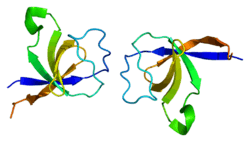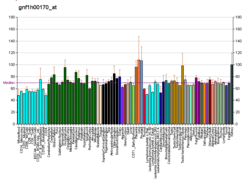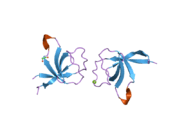BCAR1
Breast cancer anti-estrogen resistance protein 1 is a protein that in humans is encoded by the BCAR1 gene.[5][6]
Gene
BCAR1 is localized on chromosome 16 on region q, on the negative strand and it consists of seven exons. Eight different gene isoforms have been identified that share the same sequence starting from the second exon onwards but are characterized by different starting sites. The longest isoform is called BCAR1-iso1 (RefSeq NM_001170714.1) and is 916 amino acids long, the other shorter isoforms start with an alternative first exon.
Function
BCAR1 is a ubiquitously expressed adaptor molecule originally identified as the major substrate of v-Src and v-Crk . p130Cas/BCAR1 belongs to the Cas family of adaptor proteins and can act as a docking protein for several signalling partners.[7] Due to its ability to associate with multiple signaling partners, p130Cas/BCAR1 contributes to the regulation to a variety of signaling pathways leading to cell adhesion, migration, invasion, apoptosis, hypoxia and mechanical forces. p130Cas/BCAR1 plays a role in cell transformation and cancer progression and alterations of p130Cas/BCAR1 expression and the resulting activation of selective signalling are determinants for the occurrence of different types of human tumors.[7]
Due to the capacity of p130Cas/BCAR1, as an adaptor protein, to interact with multiple partners and to be regulated by phosphorylation and dephosphorylation, its expression and phosphorylation can lead to a wide range of functional consequences. Among the regulators of p130Cas/BCAR1 tyrosine phosphorylation, receptor tyrosine kinases (RTKs) and integrins play a prominent role. RTK-dependent p130Cas/BCAR1 tyrosine phosphorylation and the subsequent binding with specific downstream signaling molecule modulate cell processes such as actin cytoskeleton remodeling, cell adhesion, proliferation, migration, invasion and survival.[8] Integrin-mediated p130Cas/BCAR1 phosphorylation upon adhesion to extracellular matrix (ECM) induces downstream signaling that is required for allowing cells to spread and migrate on the ECM.[9] Both RTKs and integrin activation affect p130Cas/BCAR1 tyrosine phosphorylation[10] and represent an efficient means by which cells utilize signals coming from growth factors and integrin activation to coordinate cell responses. Additionally, p130Cas/BCAR1 tyrosine phosphorylation on its substrate domain can be induced by cell stretching subsequent to changes in the rigidity of the extracellular matrix, allowing cells to respond to mechanical force changes in the cell environment.[11]
Cas-Family
p130Cas/BCAR1 is a member of the Cas family (Crk-associated substrate) of adaptor proteins which is characterized by the presence of multiple conserved motifs for protein–protein interactions, and by extensive tyrosine and serine phosphorylations. The Cas family comprises other three members: NEDD9 (Neural precursor cell expressed, developmentally down-regulated 9, also called Human enhancer of filamentation 1, HEF-1 or Cas-L), EFS (Embryonal Fyn-associated substrate), and CASS4 (Cas scaffolding protein family member 4).[12] These Cas proteins have a high structural homology, characterized by the presence of multiple protein interaction domains and phosphorylation motifs through which Cas family members can recruit effector proteins. However, despite the high degree of similarity, their temporal expression, tissue distribution and functional roles are distinct and not overlapping. Notably, the knock-out of p130Cas/BCAR1 in mice is embryonic lethal, suggesting that other family members do not show an overlapping role in development.[12][13]
Structure
p130Cas/BCAR1 is a scaffold protein characterized by several structural domains. It possesses an amino N-terminal Src-homology 3 domain (SH3) domain, followed by a proline-rich domain (PRR) and a substrate domain (SD). The substrate domain consists of 15 repeats of the YxxP consensus phosphorylation motif for Src family kinases (SFKs). Following the substrate domain is the serine-rich domain, which forms a four-helix bundle. This acts as a protein-interaction motif, similar to those found in other adhesion-related proteins such as focal adhesion kinase (FAK) and vinculin. The remaining carboxy-terminal sequence contains a bipartite Src-binding domain (residues 681–713) able to bind both the SH2 and SH3 domains of Src.[14][15] p130Cas/BCAR1 can undergo extensive changes in tyrosine phosphorylation that occur predominantly in the 15 YxxP repeats within the substrate domain and represent the major post-translational modification of p130Cas/BCAR1. p130Cas/BCAR1 tyrosine phosphorylation can result from a diverse range of extracellular stimuli, including growth factors, integrin activation, vasoactive hormones and peptides ligands for G-protein coupled receptors. These stimuli triggers p130Cas/BCAR1 tyrosine phosphorylation and its translocation from cytosol to the cell membrane.[15]
Clinical significance
Given the ability of p130Cas/BCAR1 scaffold protein to convey and integrate different type of signals and subsequently to regulate key cellular functions such as adhesion, migration, invasion, proliferation and survival, the existence of a strong correlation between deregulated p130Cas/BCAR1 expression and cancer was inferred. Deregulated expression of p130Cas/BCAR1 has been identified in several cancer types. Altered levels of p130Cas/BCAR1 expression in cancers can result from gene amplification, transcription upregulation or changes in protein stability. Overexpression of p130Cas/BCAR1 has been detected in human breast cancer, prostate cancer, ovarian cancer, lung cancer, colorectal cancer, hepatocellular carcinoma, glioma, melanoma, anaplastic large cell lymphoma and chronic myelogenous leukaemia.[16] The presence of aberrant levels of hyperphosphorylated p130Cas/BCAR1 strongly promotes cell proliferation, migration, invasion, survival, angiogenesis and drug resistance.[13] It has been demonstrated that high levels of p130Cas/BCAR1 expression in breast cancer correlate with worse prognosis, increased probability to develop metastasis and resistance to therapy.[17][18][19][20][21] Conversely, lowering the amount of p130Cas/BCAR1 expression in ovarian, breast and prostate cancer is sufficient to block tumor growth and progression of cancer cells.[7][21][22]
p130Cas/BCAR1 has potential uses as a diagnostic and prognostic marker for some human cancers. Since lowering p130Cas/BCAR1 in tumor cells is sufficient to halt their transformation and progression, it is conceivable to propose p130Cas/BCAR1 may represent a therapeutic target. However, the non-catalytic nature of p130Cas/BCAR1 makes difficult to develop specific inhibitors.[23]
References
- 1 2 3 ENSG00000285460 GRCh38: Ensembl release 89: ENSG00000050820, ENSG00000285460 - Ensembl, May 2017
- 1 2 3 GRCm38: Ensembl release 89: ENSMUSG00000031955 - Ensembl, May 2017
- ↑ "Human PubMed Reference:".
- ↑ "Mouse PubMed Reference:".
- ↑ Dorssers LC, van Agthoven T, Dekker A, van Agthoven TL, Kok EM (Oct 1993). "Induction of antiestrogen resistance in human breast cancer cells by random insertional mutagenesis using defective retroviruses: identification of bcar-1, a common integration site". Mol Endocrinol. 7 (7): 870–8. doi:10.1210/me.7.7.870. PMID 8413311.
- ↑ Brinkman A, van der Flier S, Kok EM, Dorssers LC (Feb 2000). "BCAR1, a human homologue of the adapter protein p130Cas, and antiestrogen resistance in breast cancer cells". J Natl Cancer Inst. 92 (2): 112–20. doi:10.1093/jnci/92.2.112. PMID 10639512.
- 1 2 3 Cabodi S, del Pilar Camacho-Leal M, Di Stefano P, Defilippi P (2010). "Integrin signalling adaptors: not only figurants in the cancer story". Nat. Rev. Cancer. 10 (12): 858–70. doi:10.1038/nrc2967. PMID 21102636.
- ↑ Defilippi P, Di Stefano P, Cabodi S (2006). "p130Cas: a versatile scaffold in signaling networks". Trends Cell Biol. 16 (5): 257–63. doi:10.1016/j.tcb.2006.03.003. PMID 16581250.
- ↑ Cary LA, Han DC, Polte TR, Hanks SK, Guan JL (1998). "Identification of p130Cas as a mediator of focal adhesion kinase-promoted cell migration". J. Cell Biol. 140 (1): 211–21. doi:10.1083/jcb.140.1.211. PMC 2132604. PMID 9425168.
- ↑ Cabodi S, Moro L, Bergatto E, Boeri Erba E, Di Stefano P, Turco E, Tarone G, Defilippi P (2004). "Integrin regulation of epidermal growth factor (EGF) receptor and of EGF-dependent responses". Biochem. Soc. Trans. 32 (Pt3): 438–42. doi:10.1042/BST0320438. PMID 15157155.
- ↑ Janoštiak R, Pataki AC, Brábek J, Rösel D (2014). "Mechanosensors in integrin signaling: The emerging role of p130Cas". Eur. J. Cell Biol. 93 (10–12): 445–54. doi:10.1016/j.ejcb.2014.07.002. PMID 25062607.
- 1 2 Honda H, Oda H, Nakamoto T, Honda Z, Sakai R, Suzuki T, Saito T, Nakamura K, Nakao K, Ishikawa T, Katsuki M, Yazaki Y, Hirai H (1998). "Cardiovascular anomaly, impaired actin bundling and resistance to Src-induced transformation in mice lacking p130Cas". Nat. Genet. 19 (4): 361–5. doi:10.1038/1246. PMID 9697697.
- 1 2 Tikhmyanova N, Little JL, Golemis EA (2010). "CAS proteins in normal and pathological cell growth control". Cell. Mol. Life Sci. 67 (7): 1025–48. doi:10.1007/s00018-009-0213-1. PMC 2836406. PMID 19937461.
- ↑ Nikonova AS, Gaponova AV, Kudinov AE, Golemis EA (2014). "CAS proteins in health and disease: an update". IUBMB Life. 66 (6): 387–95. doi:10.1002/iub.1282. PMC 4111207. PMID 24962474.
- 1 2 Sakai R, Iwamatsu A, Hirano N, Ogawa S, Tanaka T, Mano H, Yazaki Y, Hirai H (1994). "A novel signaling molecule, p130, forms stable complexes in vivo with v-Crk and v-Src in a tyrosine phosphorylation-dependent manner". EMBO J. 13 (16): 3748–56. PMC 395286. PMID 8070403.
- ↑ Barrett A, Pellet-Many C, Zachary IC, Evans IM, Frankel P (April 2013). "p130Cas: a key signalling node in health and disease". Cell. Signal. 25 (4): 766–77. doi:10.1016/j.cellsig.2012.12.019. PMID 23277200.
- ↑ Cabodi S, Tinnirello A, Bisaro B, Tornillo G, del Pilar Camacho-Leal M, Forni G, Cojoca R, Iezzi M, Amici A, Montani M, Eva A, Di Stefano P, Muthuswamy SK, Tarone G, Turco E, Defilippi P (October 2010). "p130Cas is an essential transducer element in ErbB2 transformation". FASEB J. 24 (10): 3796–808. doi:10.1096/fj.10-157347. PMID 20505116.
- ↑ Tornillo G, Bisaro B, Camacho-Leal Mdel P, Galiè M, Provero P, Di Stefano P, Turco E, Defilippi P, Cabodi S (2011). "p130Cas promotes invasiveness of three-dimensional ErbB2-transformed mammary acinar structures by enhanced activation of mTOR/p70S6K and Rac1". Eur. J. Cell Biol. 90 (2–3): 237–48. doi:10.1016/j.ejcb.2010.09.002. PMID 20961652.
- ↑ van Agthoven T, Sieuwerts AM, Meijer-van Gelder ME, Look MP, Smid M, Veldscholte J, Sleijfer S, Foekens JA, Dorssers LC (2009). "Relevance of breast cancer antiestrogen resistance genes in human breast cancer progression and tamoxifen resistance". J. Clin. Oncol. 27 (4): 542–9. doi:10.1200/JCO.2008.17.1462. PMID 19075277.
- ↑ Ta HQ, Thomas KS, Schrecengost RS, Bouton AH (2008). "A novel association between p130Cas and resistance to the chemotherapeutic drug adriamycin in human breast cancer cells". Cancer Res. 68 (21): 8796–804. doi:10.1158/0008-5472.CAN-08-2426. PMC 2597570. PMID 18974122.
- 1 2 Tornillo G, Defilippi P, Cabodi S (2014). "Cas proteins: dodgy scaffolding in breast cancer". Breast Cancer Research. 16 (5): 443. doi:10.1186/s13058-014-0443-5. PMC 4384296. PMID 25606587.
- ↑ Nick AM, Stone RL, Armaiz-Pena G, Ozpolat B, Tekedereli I, Graybill WS, Landen CN, Villares G, Vivas-Mejia P, Bottsford-Miller J, Kim HS, Lee JS, Kim SM, Baggerly KA, Ram PT, Deavers MT, Coleman RL, Lopez-Berestein G, Sood AK (2011). "Silencing of p130cas in ovarian carcinoma: a novel mechanism for tumor cell death". J. Natl. Cancer Inst. 103 (21): 1596–612. doi:10.1093/jnci/djr372. PMC 3206039. PMID 21957230.
- ↑ Dai Y, Qi L, Zhang X, Li Y, Chen M, Zu X (2011). "CrkI and p130(Cas) complex regulates the migration and invasion of prostate cancer cells". Cell Biochem. Funct. 29 (8): 625–9. doi:10.1002/cbf.1797. PMID 22144090.
Further reading
- Rozengurt E (1999). "Signal transduction pathways in the mitogenic response to G protein-coupled neuropeptide receptor agonists". J. Cell. Physiol. 177 (4): 507–17. doi:10.1002/(SICI)1097-4652(199812)177:4<507::AID-JCP2>3.0.CO;2-K. PMID 10092204.
- O'Neill GM, Fashena SJ, Golemis EA (2000). "Integrin signalling: a new Cas(t) of characters enters the stage". Trends Cell Biol. 10 (3): 111–9. doi:10.1016/S0962-8924(99)01714-6. PMID 10675905.
- Bouton AH, Riggins RB, Bruce-Staskal PJ (2001). "Functions of the adapter protein Cas: signal convergence and the determination of cellular responses". Oncogene. 20 (44): 6448–58. doi:10.1038/sj.onc.1204785. PMID 11607844.
- Panetti TS (2002). "Tyrosine phosphorylation of paxillin, FAK, and p130CAS: effects on cell spreading and migration". Front. Biosci. 7: d143–50. doi:10.2741/panetti. PMID 11779709.
- Mayer BJ, Hirai H, Sakai R (1995). "Evidence that SH2 domains promote processive phosphorylation by protein-tyrosine kinases". Curr. Biol. 5 (3): 296–305. doi:10.1016/S0960-9822(95)00060-1. PMID 7780740.
- Sakai R, Iwamatsu A, Hirano N, Ogawa S, Tanaka T, Mano H, Yazaki Y, Hirai H (1994). "A novel signaling molecule, p130, forms stable complexes in vivo with v-Crk and v-Src in a tyrosine phosphorylation-dependent manner". EMBO J. 13 (16): 3748–56. PMC 395286. PMID 8070403.
- Vuori K, Hirai H, Aizawa S, Ruoslahti E (1996). "Introduction of p130cas signaling complex formation upon integrin-mediated cell adhesion: a role for Src family kinases". Mol. Cell. Biol. 16 (6): 2606–13. PMC 231251. PMID 8649368.
- Law SF, Estojak J, Wang B, Mysliwiec T, Kruh G, Golemis EA (1996). "Human enhancer of filamentation 1, a novel p130cas-like docking protein, associates with focal adhesion kinase and induces pseudohyphal growth in Saccharomyces cerevisiae". Mol. Cell. Biol. 16 (7): 3327–37. doi:10.1128/mcb.16.7.3327. PMC 231327. PMID 8668148.
- Khwaja A, Hallberg B, Warne PH, Downward J (1996). "Networks of interaction of p120cbl and p130cas with Crk and Grb2 adaptor proteins". Oncogene. 12 (12): 2491–8. PMID 8700507.
- Salgia R, Pisick E, Sattler M, Li JL, Uemura N, Wong WK, Burky SA, Hirai H, Chen LB, Griffin JD (1996). "p130CAS forms a signaling complex with the adapter protein CRKL in hematopoietic cells transformed by the BCR/ABL oncogene". J. Biol. Chem. 271 (41): 25198–203. doi:10.1074/jbc.271.41.25198. PMID 8810278.
- Garton AJ, Flint AJ, Tonks NK (1996). "Identification of p130(cas) as a substrate for the cytosolic protein tyrosine phosphatase PTP-PEST". Mol. Cell. Biol. 16 (11): 6408–18. PMC 231642. PMID 8887669.
- Liu F, Hill DE, Chernoff J (1997). "Direct binding of the proline-rich region of protein tyrosine phosphatase 1B to the Src homology 3 domain of p130(Cas)". J. Biol. Chem. 271 (49): 31290–5. doi:10.1074/jbc.271.49.31290. PMID 8940134.
- Astier A, Avraham H, Manie SN, Groopman J, Canty T, Avraham S, Freedman AS (1997). "The related adhesion focal tyrosine kinase is tyrosine-phosphorylated after beta1-integrin stimulation in B cells and binds to p130cas". J. Biol. Chem. 272 (1): 228–32. doi:10.1074/jbc.272.1.228. PMID 8995252.
- Jücker M, McKenna K, da Silva AJ, Rudd CE, Feldman RA (1997). "The Fes protein-tyrosine kinase phosphorylates a subset of macrophage proteins that are involved in cell adhesion and cell-cell signaling". J. Biol. Chem. 272 (4): 2104–9. doi:10.1074/jbc.272.4.2104. PMID 8999909.
- Manié SN, Beck AR, Astier A, Law SF, Canty T, Hirai H, Druker BJ, Avraham H, Haghayeghi N, Sattler M, Salgia R, Griffin JD, Golemis EA, Freedman AS (1997). "Involvement of p130(Cas) and p105(HEF1), a novel Cas-like docking protein, in a cytoskeleton-dependent signaling pathway initiated by ligation of integrin or antigen receptor on human B cells". J. Biol. Chem. 272 (7): 4230–6. doi:10.1074/jbc.272.7.4230. PMID 9020138.
- Schlaepfer DD, Hunter T (1997). "Focal adhesion kinase overexpression enhances ras-dependent integrin signaling to ERK2/mitogen-activated protein kinase through interactions with and activation of c-Src". J. Biol. Chem. 272 (20): 13189–95. doi:10.1074/jbc.272.20.13189. PMID 9148935.
- Manié SN, Astier A, Haghayeghi N, Canty T, Druker BJ, Hirai H, Freedman AS (1997). "Regulation of integrin-mediated p130(Cas) tyrosine phosphorylation in human B cells. A role for p59(Fyn) and SHP2". J. Biol. Chem. 272 (25): 15636–41. doi:10.1074/jbc.272.25.15636. PMID 9188452.
- Garton AJ, Burnham MR, Bouton AH, Tonks NK (1997). "Association of PTP-PEST with the SH3 domain of p130cas; a novel mechanism of protein tyrosine phosphatase substrate recognition". Oncogene. 15 (8): 877–85. doi:10.1038/sj.onc.1201279. PMID 9285683.
- Kanda H, Mimura T, Morino N, Hamasaki K, Nakamoto T, Hirai H, Morimoto C, Yazaki Y, Nojima Y (1997). "Ligation of the T cell antigen receptor induces tyrosine phosphorylation of p105CasL, a member of the p130Cas-related docking protein family, and its subsequent binding to the Src homology 2 domain of c-Crk". Eur. J. Immunol. 27 (8): 2113–7. doi:10.1002/eji.1830270840. PMID 9295052.
External links
- Bcar1 Info with links in the Cell Migration Gateway
- Human BCAR1 genome location and BCAR1 gene details page in the UCSC Genome Browser.






